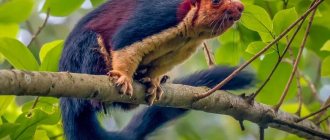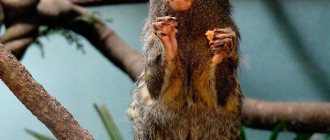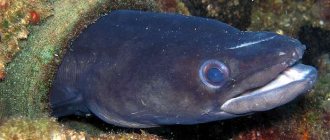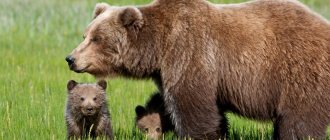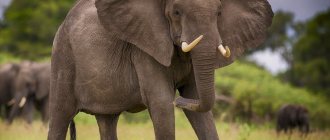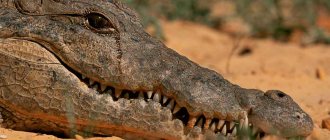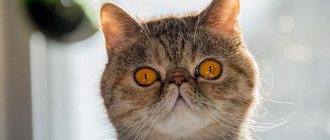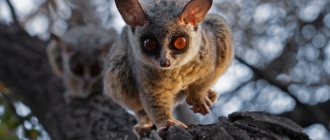Author: Dimon
11 May 2022 20:43
Community: Animals
Tags: animals educational facts
9403
11
Monkeys are quite cute animals, but when they are the size of your palm, the degree of cuteness increases several times. It's hard to imagine a person who hasn't seen a monkey. Although they do not live in our usual habitat, but prefer tropical forests, they have become frequent residents of circuses, zoos and other shows involving various animals. They are easy to tame and teach certain actions.
0
See all photos in the gallery
The smallest monkeys in the world have an easy-going and friendly character; over time, this animal can become a good friend for its owner. In addition, they are very smart and quick-witted. Our article presents ten tiny primates and describes the characteristics of these animals with photographs. The length of some barely exceeded 10 centimeters.
×
Golden lion marmoset
0
— Body length: 20-25 centimeters. — Weight: about 900 grams. This is the largest monkey of the marmoset family. Its tail can grow up to 37 centimeters. The golden lion tamarin gets its name from its resemblance to a lion. Around the monkey's head there is fur like a mane, which glows golden in the sun. All wool shimmers beautifully in the sun's rays and is therefore compared to gold dust. Marmosets take care of their appearance and always take care of their fur. They live mainly in groups of 3 to 8 members.
Diet of the red howler monkey
The red howler feeds on leaves, unripe fruits, moss, bark, nuts, and flowers. The diet includes about 195 plant species from 47 families. Such food is not very high in calories, as it contains a lot of fiber, so the body receives little energy.
The red howler also feeds on insects and their larvae, and sometimes catches small mammals.
Bacteria live in the primate’s digestive system; they help digest rough plant foods consisting of cellulose.
Sometimes monkeys eat only leaves for a long time, but their body does not experience a deficiency of microelements and nutrients. The red howler monkey disperses seeds from 95% of plant species in the rainforest ecosystem.
The digestive tract of red howler monkeys is well adapted to plant foods.
Black lion marmoset
0
— Body length: 25-24 centimeters. — Weight: about 500-600 grams. These monkeys are completely black except for their red buttocks. There is a thick mane around the head. Their muzzle is flat and hairless. The tail can reach 40 centimeters in length. Black lion marmosets live for about 18 years. However, recently their numbers have decreased significantly. They have been given the status of “endangered”. The habitat of these monkeys is gradually being destroyed, and poachers are hunting for individuals.
Red-handed tamarin
0
— Body length: 30 centimeters. — Weight: about 500 grams. The animals are most common in South America and Brazil. Their tail is larger than their body and can grow up to 45 centimeters. The color is black except for the arms and legs, which are yellowish or orange-red. The red-handed tamarin is unpretentious in food. They can eat insects and spiders, as well as lizards and birds. They also do not refuse plant foods and actively consume various fruits. Tamarins are active during the daytime. They live in a family circle of 3-6 individuals. Within the group they are friendly and look after each other. They have only one dominant female who bears offspring. By the way, only males take care of newborns. They carry them everywhere with them and only bring them to the female for feeding.
External signs of a red howler
Males of the red howler have a body length of 49-72 centimeters, weight - 5.2 - 7.0 kilograms, females are 46-57 cm long and weigh 4.1 - 5.0 kg. The tail is long - 51-73 cm, on the lower side one-third bare, it performs a grasping function.
The color of the coat is red-brown or reddish-brown. The fur is long and soft like silk. The neck is thick. The muzzle is hairless, but has fur along the edges. The tip of the nose is raised. The lower jaw protrudes forward, adapted for grinding coarse plant food.
Red howler monkey (Alouatta seniculus).
Developed jaws, an enlarged larynx and hyoid apparatus contribute to the functioning of the resonator. Enlarged and highly specialized vocal cords allow the red howler to produce loud howls, grunts, growls and barks. The upper molars are sharp, necessary for thoroughly crushing branches and leaves.
The salivary glands are large and secrete saliva containing enzymes that break down the tannins of the leaves, facilitating digestion in the stomach and intestines. The intestine makes up about 1/3 of the body.
Silver marmoset
0
— Body length: 22 centimeters. — Weight: about 350 grams. The fur color of the silver marmoset ranges from silver to brown. The tail is black and grows up to 29 centimeters. They live in large family groups of about 12 individuals. Within a group there is a dominant and a subordinate. Only the dominant female produces offspring; the rest do not participate in reproduction. The female gives birth to no more than two cubs. After six months, they already switch to adult food, and at the age of 2 years they are considered independent and adult individuals. For the entire six months, when the cub feeds only on mother’s milk, the male takes care of it and carries it on his back.
Crested marmoset
0
— Body length: 20 centimeters. — Weight: about 450 grams. They received this name due to their unusual crest. The crested marmoset has a snow-white crest running from its forehead to the back of its head. This hairstyle makes it very easy to recognize the monkey's mood. For example, if she is angry, her crest rises. When severely irritated, monkeys bar their teeth ferociously. They have a very unusual appearance, which is immediately remembered and it is impossible to confuse them with another species. Monkeys prefer to live in the forests of Colombia and Panama.
Geoffroy's Marmoset
0
— Body length: 20 centimeters. — Weight: about 190-250 grams. They have incisors with which they gnaw through the bark of trees in search of tree sap. During the rainy season, they spend most of their time resting and getting food, but during the drought they are very active. When it comes to food, Geoffroy's marmosets are unpretentious. Their diet includes insects, fruits, plants and tree sap. They live in large groups (8-10 individuals) with one dominant pair. The cubs are cared for by all members of the group until they are 18 months old. Then they become independent.
Peculiarities of behavior of the red howler
Red howler monkeys are sedentary forest dwellers and spend most of their lives in trees. They prefer to stay in the center of the top layer, although they can live at all levels of the rainforest, and can even climb down to cover short distances between trees on the ground.
Red howler monkeys sleep for 15 hours, 70% of the time they lie on tree trunks. At dawn, monkeys emit loud cries, thus they communicate with other flocks, determining the location of other relatives and their numbers.
The group usually contains up to 10 individuals, led by an experienced male.
At the same time, conflicts for leadership constantly arise in the pack. Therefore, young males leave the group to gather their own pack. Sometimes young howler monkeys try to take a dominant position in the pack, while they destroy their competitors - other young males. Of course, the females protect them, but only a quarter of the cubs survive.
Red howler monkeys are active in the morning and evening. They move along branches using their limbs and tail, using it for balance and pulling branches with fruits. During the rainy season, red howler monkeys sit motionless in the trees, waiting for the rain to end.
A flock of howler monkeys moves only four hundred meters a day.
Marmoset Göldi
0
— Body length: 20-23 centimeters. — Weight: about 350 grams. This species is protected and movement through customs is strictly limited. The tail of Göldi's marmoset is larger than its body and grows up to 15 centimeters. They live for about 18 years, but with proper care at home or in special institutions for animals, life expectancy increases by 5-6 years. Her appearance is very unusual, but despite her small size, her muzzle expression is very concentrated and even a little angry. In the wild, they are shy and do not let anyone get close, but if a person manages to tame them, they will become excellent friends.
Population and species status
Despite the fact that these primates are not included in the International Red Book, their numbers are constantly decreasing, which causes unfounded fears among specialists in many countries around the world. In China, it is prohibited to trade these animals, so it is not possible to legally obtain such a pet. Despite this, illegal trade continues. The cost of one such pet reaches about 3 and a half thousand dollars.
The cost is quite high, since some jewelry is sold at this price, although the attitude towards animals is not so reverent and attentive. At first, such pets are surrounded with care, but after some time they are simply forgotten about, or even thrown away altogether. Not everyone understands that you should treat a little marmoset the way a person would treat a small child. Therefore, you should not think that a marmoset will have a sufficiently spacious cage, enough treats and a sufficient mass of all kinds of toys. Since these primates live in friendly families, attention and communication are very important for them, the absence of which is extremely difficult for them to tolerate.
The smallest monkey in the world (Geldi's Marmoset)
Common marmoset
0
— Body length: 16-17 centimeters. — Weight: about 150-190 grams. The size of this monkey is more like a squirrel. Adults have a distinctive feature - large white tufts on their ears made of long hair. These monkeys are very emotional and quickly fall into unreasonable panic. Their emotions are expressed through gestures and facial expressions. It is very easy to understand what exactly an ordinary marmoset is experiencing at the moment. They live in family groups of up to 15 members. They resolve all territorial conflicts with neighbors using sounds; as a rule, they do not like to fight. The average life expectancy in nature is about 12 years. At 2 years old, the individual is already considered an adult.
Tiny marmoset
0
— Body length: 18 centimeters. — Weight: about 150-180 grams. The coat color is mainly olive-brown, with golden-yellow or gray-yellow on the belly. Most often found in the Amazon rainforest and Brazil. In total there are about 10 thousand individuals. The tail is up to 23 centimeters long, completely black. The ears and face are mostly hairless, but there is a large tuft of hair on the head by which this species of monkey can be easily distinguished. The tiny marmoset is not as common as the pygmy marmoset, but they are still often kept as pets.
Orangutan: Great Red Ape
The opportunity to buy any animal as a pet for money can please the owner of the rarity, but if he himself is extremely ignorant in biology and is not interested in the needs of a living creature, this joy only harms the pet. Once, the staff of the British animal rescue center “Monkey World” had to create a diet for weight loss of an orangutan named Oshin, who was monstrously fed by her previous owners in South Africa. For thirteen years, the monkey lived in a private house as a member of the family, all this time it was regularly fed with fast food and sweets. As a result, Oshin began to look like a shaggy red ball weighing about a hundredweight instead of the 30-50 kg required for her age. According to the owners, they did not at all want to harm their pet. Feeding was just an effective way to calm the capricious primate. This is the case when simplicity is worse than theft. And the luck of poor fellow Oshin that he fell into experienced hands in time...
Accused without guilt
The Malay phrase "orang utan" literally means "man of the forest". The Dayaks living on the island of Kalimantan call this monkey the word “Mayas”, which roughly means the same thing. Zoologists and naturalists around the world usually use the short version "orang". Alas, the word “orangutan” will not be eradicated from the Russian language, the use of which is not only ignorant, but also offensive: translated from Malay it means “debtor”.
It would be interesting to know who the “forest man” owed? Slander is a sign of lack of culture. This is despite the fact that the culture of orangutans themselves has existed for hundreds of thousands of years, since they became a separate species. After 10 years of research, an international group of scientists led by Karel van Schaik from Duke University (USA) came to this conclusion. Anthropologists have identified 24 behavior patterns of orangutans (including simple rituals), which are transmitted through imitation and are a direct sign of culture. You can call it first culture, but you cannot dismiss it.
How does a person differ from an animal? They say the use of tools, speech and the ability to laugh. As for the tools, orangs cover themselves from the rain with large leaves, using them as umbrellas, they can scratch their backs with a gnarled stick, they extract honey from hollows and insects from cracks with a specially broken twig. Experiments on teaching these monkeys the alphabet of deaf-mute people showed that their language abilities are no worse than those of a 2-3-year-old person. And the fact that many of them can laugh and joke even better than other people is known to anyone who has seen them at least on TV. And in general, what kind of scores can there be between our own? Indeed, despite all the external differences, genetically the orangutan differs from humans by only 3%. We have common blood types (except the first) and 12 pairs of ribs, while other apes have 13...
Perhaps, once upon a time, a certain orangutan tore the glasses off the nose of a certain philologist who came to the zoo, and the idiot harbored rudeness against all the relatives of one monkey, indiscriminately declaring them debtors? It may very well be. But the Orangs don’t owe anything to other people; it’s humanity that owes them a fair amount.
Where do you live, do you look like those people
“Big red monkey” - these three words accurately and figuratively characterize our hero. He is truly the largest primate in Asia, and among the world's monkeys he is second in size only to the gorilla. The height of males is from 1.2 to 1.5 meters, and the average weight is 80-100 kg. The span of the amazingly long arms, according to some sources, exceeds 2.4 meters. Even when the orang stands tall, its arms hang almost to the ground. With a sedentary lifestyle and an abundance of food, some males in captivity become very obese, turning into monsters weighing 140 kg (if you believe a number of authors, then 180-200 kg is not the limit). But females are much smaller and slimmer.
In appearance, the bright reddish-brown orangutan is completely different from other anthropoids, although it is similar to gorillas and chimpanzees due to the intelligent and penetrating gaze of its small, close-set eyes. It seems that the leisurely orangs look philosophically at the world around them - dispassionate, like adherents of the Buddha. In their youth, they are all cute and fluffy, but in males, as they age, the hair on their shoulders and forearms grows up to 40 cm, hanging in long tufts. In general, the older the male, the more beautiful and colorful he is, and at the same time, the more scary. A mature orang is distinguished by a white or yellowish beard and mustache growing not on the upper lip, but on its sides, as is typical for many men - representatives of the Mongoloid race. After 14-15 years, a huge resonator bag forms under his throat, falling onto his chest to enhance his voice, and his face widens due to the formation of the so-called cheek ridges. They are filled with subcutaneous fat bound by connective tissue and grow until old age. And their purpose is simple: so that at one glance at this wide face, any oncoming and transverse Mayas understands what a serious brother he is on his way.
In contrast to their long and strong arms, orangutans' legs are short and weak. At the same time, both the fingers and toes, except for the shortened thumb, are equally well developed. The “forest man” makes no difference in the use of his limbs: he can cling to a branch with this “hook”, or he can hold an apple in it. It is immediately clear that their owner will not come down from the tree any time soon.
Between heaven and earth
“Forest people” spend most of their lives high in the treetops. Easily climbing to the height of a 12-story building, the orangutan feels more than confident there. Using the weight of his body, he swings like an orange pendulum from branch to branch, from tree to tree, swinging with an elegance that is difficult to expect from him. In the crowns, the shaggy high altitude bird eats and sleeps, arranging simple but convenient nesting platforms from branches and foliage at night. To avoid accidentally falling out of the nest, the orang insures itself by holding onto a branch with its hand or foot. If there is enough food around, it uses one nest for several days, otherwise it builds a new one each time.
A sane orangutan will be forced to come down to earth by too much distance between the trees, less often by a female with which to mate, or by thirst. Although he will decide to drink on the ground only in the most difficult times, when there is no water in the hollows and leaves. The exception is the old heavy male, whose weight the branches cannot support, and therefore he has to wander below. But orangs do not know how to swim, so any river actually poses an insurmountable obstacle for them.
Almost all males lead a solitary life (excluding mating season). Young ones actively travel in anticipation of maturity, mature ones often sit still, in the center of a territory with an area of 2-6 square meters. km, covering the areas of several females with cubs. The Orang's vocal repertoire includes about 13 sounds. Within a small group, they communicate by smacking their lips, when frightened, they scream, and seasoned dominant males periodically fill the forest with a roar that can be heard at a distance of up to a kilometer. These sounds can establish space between neighboring males to avoid bloody boundary conflict, scare away competitors and call females for mating.
Orangutans can rarely be seen in company. This happens, for example, when a female with cubs meets a similar family. Then the mothers take a break, watch each other, and the children get to know each other and start playing games. But now the rest is over and the groups go their separate ways. And during the season of abundant fruiting, scientists encountered up to eight feeding animals in the neighborhood on trees strewn with fruit. When there is an abundance of food, even dominant males tolerate the close presence of each other, but with the onset of dark days, a meeting of mature males of equal strength can end in a fierce fight and the death of one of the rivals.
In search of their daily bread, orangs are able to travel considerable distances. They know not only every tree on their territory. Their memory stores precise information about what fruits grow on each tree and at what time they ripen. Researchers have counted more than 400 components in the menu of wild orangutans, although the main part of it consists of forest fruits: rambutan, lychee, mango, figs, but Mayas has a special weakness for the prickly and fragrant durian fruits. Leaves and shoots, flowers and bark make up a smaller proportion of the diet. Insects (mainly termites), bird eggs and chicks, and sometimes carrion are used as protein supplements. It is extremely rare for a more serious – almost cannibalistic – treat to happen. In the Indonesian national park Gunung Löser, an adult couple of orangutans were observed eating a white-handed gibbon without a trace...
Two instead of one?
About 10 thousand years ago, orangutans lived from India and southern China to Australia. Nowadays, their habitat area has shrunk catastrophically due to deforestation of the jungle and the growth of the human population in Asia. The only place where you can now see red monkeys in nature is the rainforests of the islands of Kalimantan (Borneo) and Sumatra, which belong to Malaysia and Indonesia. They inhabit exclusively tropical rainforests, in different landscapes - from swampy to mountainous, rising up to 1500 m above sea level.
Until recently, two subspecies of orangutans were distinguished: Bornean and Sumatran. According to some zoologists, both differ well in size (the first is larger), head shape, beard color, fur shade, and the size of the cheek ridges. Others believed that animals outside their home islands, as a rule, could only be reliably identified through chromosomal or DNA analysis. Well, they “did chromosomes.” At an international working meeting of primatologists in Orlando (Florida, USA), a revision in the taxonomy of “forest people” was announced. Nowadays it is correct to consider them two independent species, since genetic data have shown that the Mayas of Borneo and Sumatra are as far from each other as chimpanzees and gorillas. It must be said that not all scientists yet agree with this systematic revolution. Conservatives are stubborn. Well, the orangutans themselves are not aware of these debates...
“...like a madman with a razor in his hand”
Representatives of all species of great apes live comfortably in the Pongoland exhibition complex of the Leipzig Zoo. Near the orangutan enclosure, the mighty male Bimbo caught my attention. What a rewarding object for a photographer, and even in color... Being carried away, I forgot about my guide - the chief veterinarian of the zoo, Professor Klaus Euhlenberger. But in the dense crowd of visitors, Bimbo spotted him. Surely he had not the most pleasant experiences with this man: few people like injections. Alas, I had just turned to the playful young orangs and missed the moment when Bimbo stood up abruptly and, growling a strong curse in his own language towards the doctor, walked away irritably. Even a tiger would envy the power of this roar. I don’t know about anyone, but my soul would definitely sink into my boots if I suddenly heard such a sound in the dense jungle!
Is the orangutan dangerous to humans? Potentially - yes, of course, like any large animal. Firstly, an adult primate has powerful jaws with 32 teeth, among which large fangs stand out, and with equal success it will crack a hard nut and chop off a stranger’s finger. Even a cub, in defense, can bite quite hard. Secondly, an average-sized adult orang (not to mention the most powerful males) is at least eight times stronger than an average human and, if angry, can easily strangle him.
When Edgar Allan Poe wrote his famous story “Murder in the Rue Morgue,” he did not exaggerate at all. Having escaped from a strict owner and finding himself on city streets full of all kinds of stress factors, the orangutan was inevitably excited. Excitement quickly gives way to hysterical fury, and when the beast gets his hands on a straight razor, he is capable of causing great trouble, forgetting all the rules of orangutan etiquette... So the terrible story described in the story could well be true.
The English zoologist John MacKinnon, who studied the life of red monkeys in the forests of Sumatra and Borneo, more than once had to find himself in, to put it mildly, delicate situations. For example, to flee from a heavy male, who, due to his considerable weight, preferred to walk not in the treetops, but on the ground. And among the females with cubs there are real furies, who see a threat to their baby everywhere. However, such individuals are rather the exception. In general, if you do not provoke orangs by looking them straight in the eyes (a manifestation of aggression in the animal world) or violating the permissible distance, they behave peacefully.
Family matters
A female orangutan can bear children for over 30 years. Whenever the time comes, she goes to the drawn-out loud call of the broad-faced, shaggy ruler of the local forest. But their honeymoon lasts only a couple of days, after which they separate for years.
After 8–9 months of philosophical waiting, the mother reveals to the world a baby weighing about 1.5 kg (occasionally twins are born). Until the age of 4, an orang is considered a baby. For another 4 years he goes through the child stage, continuing to stay with his mother. She teaches him everything that will be useful to him in later life: how to find and collect food, how to move from tree to tree without falling down, and other unwritten rules of survival in nature. But no matter how you teach, a female rarely manages to raise more than 4-5 children in her entire life; most babies die from pneumonia, malaria and other serious diseases.
Red monkeys mature in adolescence: females from 8 to 15 years, males - up to 13, plus another 5 years are considered juveniles. Only after their 15th and 18th birthdays, respectively, females and males can be called fully adults. Although a fundamentally young male is ready to give birth to a new generation of “forest people” from the age of 12. But he will still have to wander for a long time, running away when meeting with seasoned orangutans, because he is not yet strong enough to resist them. However, he has a chance to become a father ahead of schedule if he meets a young romantic lady who is horrified at the sight of a roaring, shaggy monster, the owner of the surrounding jungle. Such a maiden will easily yield to the charm of a modest, slender young man, who, upon meeting, tenderly takes her hand in his. And they will get along without shouting and serenades...
In nature, orangutans live up to a maximum of 35–40 years, but in captivity their lifespan lasts much longer. It is believed that the male Guas from the Philadelphia Zoo (USA), who died on February 9, 1977, lived at least 58–59 years, and this record of longevity for red-haired primates has not yet been broken.
Reason for pessimism
According to various experts, there are less than 20 thousand wild orangutans left on Earth, and maybe about 15 thousand. There are no guarantees of safety for them, despite the work of several rehabilitation centers established both in Sumatra and Borneo, and the titanic efforts of enthusiasts waging an endless battle for the survival of the species. More than 70% of the Indonesian jungle has already been cut down; the remaining area occupies about 100 million hectares and is decreasing by 2 million annually. How long will it last if illegal logging is not controlled? And the forest fires that destroyed more than 5 million hectares of Eastern Borneo jungle in 1997–1998 alone? Another misfortune was reported by the Indonesian news agency Antara: it turns out that already 90% of Kalimantan orangutans suffer from jaundice, tuberculosis, influenza and other “human” diseases...
An equally serious threat is the illegal pet trade. It is pointless to catch an adult animal (it won’t get used to it and will soon die), so they drag babies out of the forest, killing their mothers. According to statistics, for every orang successfully transported from the wild to the zoo, three die. To influence the situation, the world's leading zoos comply with a convention prohibiting the purchase of smuggled orangutans, and transfer those born in captivity to each other free of charge as part of a special international program. However, many menageries and circuses, not to mention private collectors, buy young Mayas without a twinge of conscience, despite the fact that the price of a cub in Malaysia and Taiwan ranges from 6 to 15 thousand dollars, and in the USA and Europe this figure doubles. Every day, according to the Indonesian press, up to five young orangs are sold on the black market in Jakarta.
The work of the centers to teach orphaned and confiscated red monkeys about forest life and release them into the wild bears some fruit, but no more than half of those who undergo rehabilitation survive. By and large, the feasibility of this idea remains quite doubtful. Primates who grew up without a mother have a hard time getting used to wild life, they are aggressively greeted by their relatives, and their immunity is weakened. But even if these attempts are just a drop in the ocean, doing nothing is even worse...
As a critically endangered species, the orangutan is listed on the International Union for Conservation of Nature Red List and Appendix I of the Convention on International Trade in Animals (CITES). However, the number of orangutans in Sumatra is decreasing by 1 thousand individuals every year, and in Borneo this figure is even more alarming. Unless a miracle happens, in 10–20 years you will only be able to see the great red monkey in a zoo. But the trouble is, all over the world there are not as many zoos as are needed for the survival of the species, and even fewer zoos capable of adequately maintaining orangs, creating conditions for them to reproduce.
Their final resting place?
It is believed that the first “forest people” came to Europe at the beginning of the 18th century. They were brought by sailors and traders, who purchased young orangs from the Dayaks and Malays as pets or simply living souvenirs. The zoo history of the species dates back to 1825. The living conditions were far from ideal for a long time: a dark cage with a shelf for sleeping next to bears, lions and tigers. And loneliness. The owners of menageries of the 19th and 20th centuries most often could not afford the luxury of purchasing a pair of expensive monkeys.
The first case of orangutans breeding in captivity dates back to 1928, but they began to produce offspring more or less steadily since the 1970s. It was at that time that leading zoos began to improve the living conditions of their inhabitants, setting a course for breeding rare species. In 1969, according to the first edition of the International Stud Book of Orangutans, 460 of these animals lived in zoos around the world, but now their total number has almost doubled. Today, pavilions with tropical vegetation and magnificent outdoor walks are built for them, giving inquisitive monkeys plenty of opportunities not to get bored. Since orangs are very inventive in finding a way to escape, any new premises are carefully thought out from this point of view. Nevertheless, it turned out that the enclosures and walking areas of great apes also need to be made impenetrable to outsiders. A rabbit that several years ago snuck into the new outdoor run of five orangutans at the Topeka Zoo (Kansas, USA) turned out to be a carrier of tularemia. When he died, the monkeys, unfortunately, managed to discover him before the servants. As a result, three of them fell ill, and the life of one orang could not be saved.
It turned out that red hermits from the forests of Borneo and Sumatra get along well in family groups, especially if the animals are kept together from a young age. For example, in April 2016, 8 orangs were kept in the Leipzig Zoo, 10 and 12 in the Zurich (Switzerland) and Perth (Australia) zoos, respectively, in the Apenheul monkey park in the Dutch Apeldoorn - 13, in the Singapore Zoo - 25... They get along peacefully, with provided that, of course, there is only one dominant male in each group. By the way, the activity of the head of the family is not limited to the role of the ruler, sitting in the pose of a meditating Buddha and from time to time performing marital duties. For example, at the Dresden Zoo they observed how a male orang once took on the role of an obstetrician, using his own long lips instead of birthing forceps, and then performed mouth-to-mouth artificial respiration on a cub that showed no signs of life. Only when the newborn began to cry did the father hand him over to the mother.
Naturally, in conditions that are comfortable in comparison with the jungle in a zoo, reproduction occurs more intensively. Thus, the female Guarina, who lived in the already mentioned Philadelphia Zoo from 1929 to 1955, became the mother of nine cubs: this is more than a baby every three years! However, such a pleasant phenomenon also has a downside. Typically, orangutans who give birth in captivity do not want to feed their offspring, so humans take over their duties. But females raised by humans again do not have maternal skills, and it is not yet possible to break this vicious circle.
In the territory of the former USSR, orangutans are now kept in zoos in Moscow and Novosibirsk. Previously, they also lived in the Leningrad, Kaliningrad, Rostov, Kiev and Tallinn zoos. Reproduction, however, was achieved only in Moscow, St. Petersburg and Kaliningrad. Moreover, the Moscow Zoo, from the late 1970s to this day, has purposefully specialized in keeping and breeding both Sumatran and Kalimantans, and the firstborn was born here in September 1981.
As for the baby orangs, which can be seen in various kinds of mini-zoos under the roofs of shopping and entertainment centers and other private zoological institutions... Every single one of them was brought smuggled, or with forged documents. And behind each of them there is a sad statistics, which was described above. In the current situation, keeping these monkeys in captivity is permissible only as part of a breeding program to increase the zoo population. But not for the purpose of entertainment, which takes place in circuses, or pseudo-enlightenment...
For a full life, rare primates require a rich menu. The diet of the orangs at the Moscow Zoo includes such components as wheat bread, bran, cereals, legumes, sprouted grains, nuts and seeds, all kinds of vegetables, watermelon, melon, fresh fruits and berries, juices, compotes, as well as meat, liver, chicken, fish, egg, milk for acidophilus, cottage cheese, tea, branches, honey, jam, jam, syrups... More than 11 kg of all sorts of things per day for each monkey. The menu of an artificially fed baby contains more than 40 components, and all milk feeds are purchased at the dairy kitchen for infants. But after a year, the zoo cub is transferred to the full diet of an adult animal.
Boredom is the main enemy of any zoo animal, especially primates. Scattering food is one way to combat it. For orangs prone to obesity, it is useful to spend time actively, moving around the enclosure or paddock in search of tidbits. Ropes, hammocks and ladders give them the opportunity to climb, car tires are good for strength exercises of the dominant male, heaps of straw allow them to realize the nest-building instinct. And large red monkeys also love to wrap themselves in pieces of burlap or, like palm leaves in the forest, cover themselves with large boxes and sheets of thick paper. Although some people use paper for its intended purpose, inspiredly drawing on it with paints and crayons something that only they know, and showing animal psychologists and anthropologists the beginnings of their ancient first culture...
613
10867
10868
10869
10870
10871
10872
10873
10874
Text and photos: Andrey Kotkin
Tags: orangutan primates
← Vase: black parrot with a Malagasy name↑ Stories about animals Little panda: the only one in its family →
